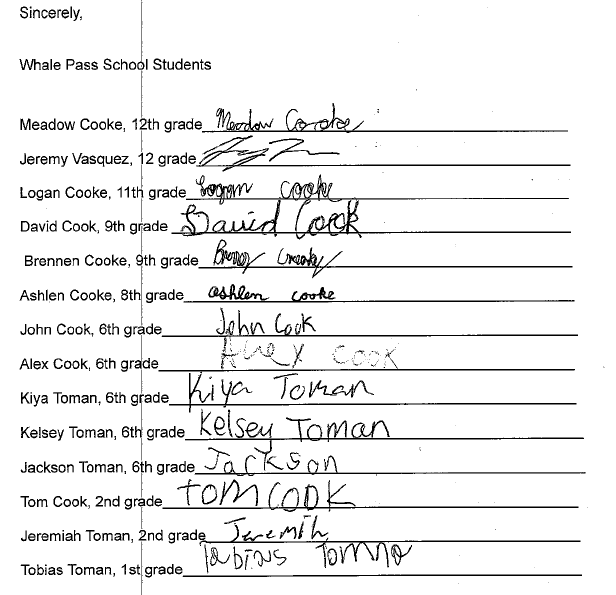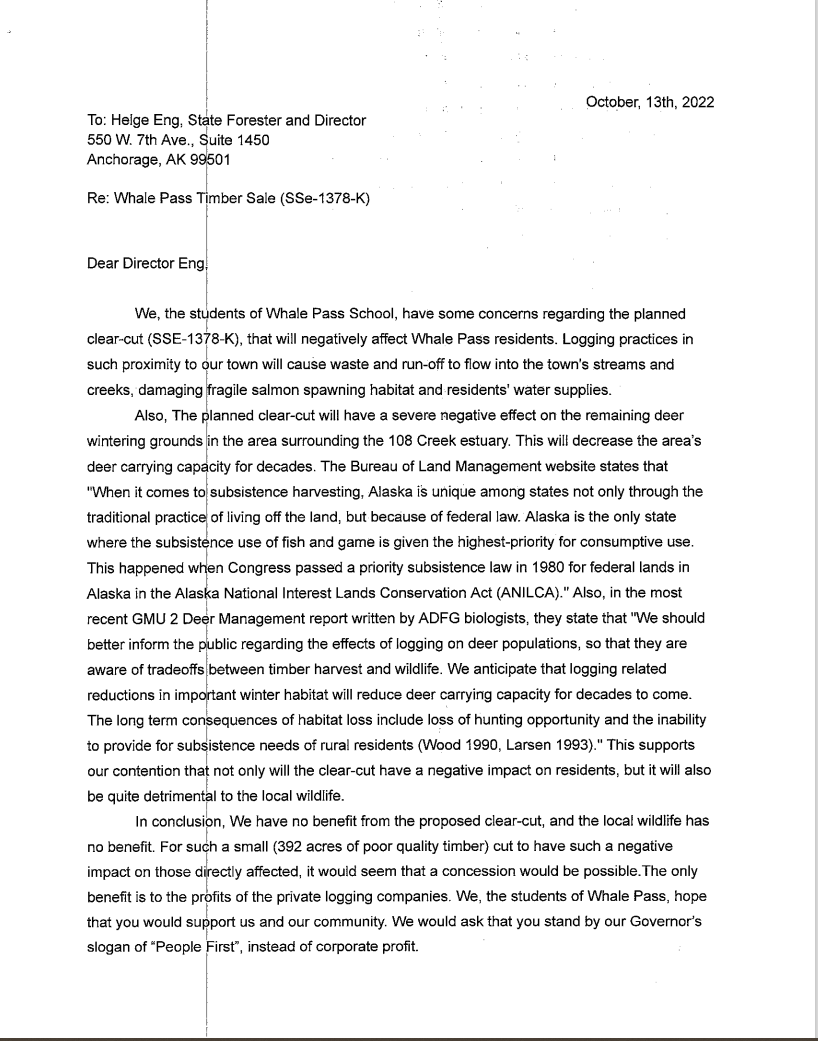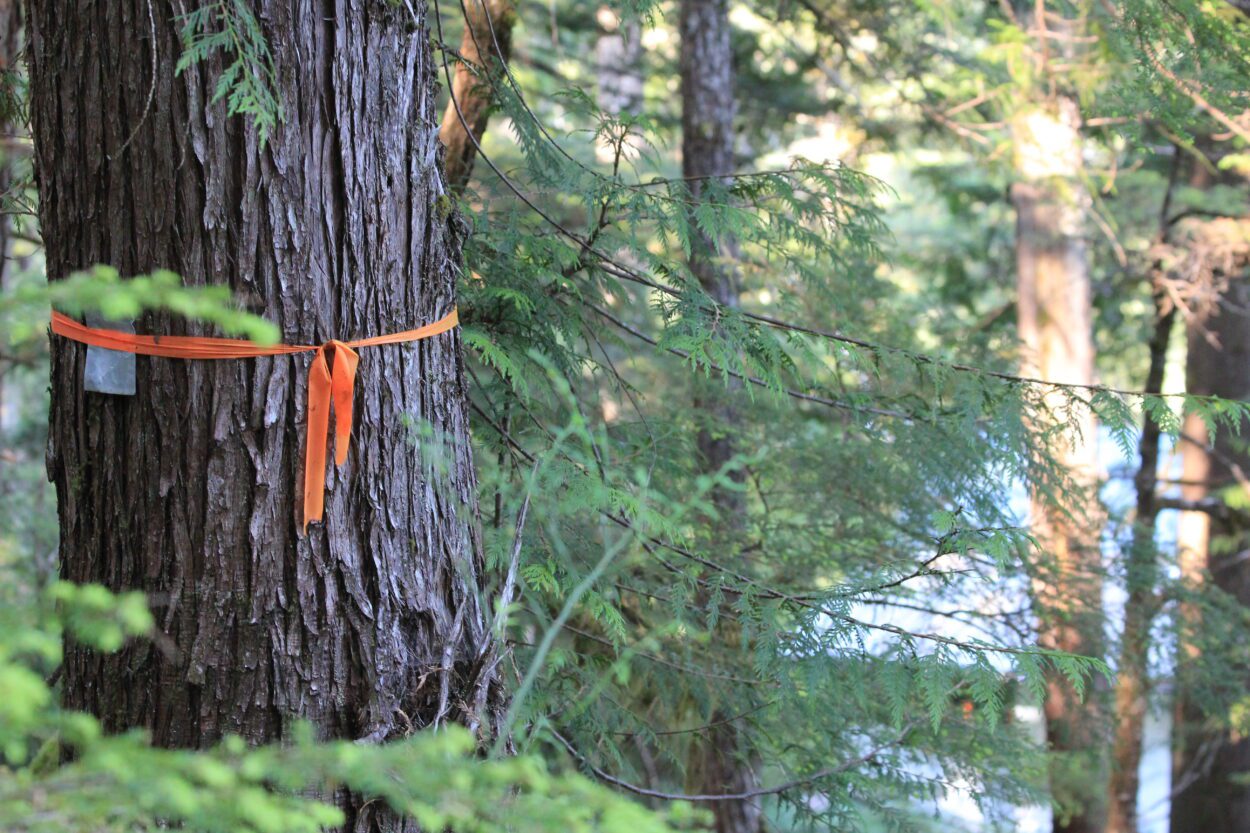
Students in the Prince of Wales Island community of Whale Pass are joining a last-ditch effort to save a local hillside from a nearly 300-acre clear cut. State forestry officials say they’ve already addressed the students’ concerns.
The letter wasn’t an assignment.
But Whale Pass School’s head teacher, Anthony Cook, said it’s an issue close to home for even the town’s youngest residents. The proposed sale would take out 292 acres of mixed-species old growth lining the hill above the town of 100. Cook said it could affect the kids’ hunting prospects, their jobs at the town’s lodge, or even their homes, just 100 feet away from the clear-cut boundary.
“It’s either them directly or their grandparents,” Cook said.
It’s a hot topic in Whale Pass. Residents have voiced strong opposition to the sale boundary — which falls just 100 feet behind many property lines. But there are also bigger fears — exposing homes to landslides, winds, or floods, and damaging subsistence habitats for deer and fish. Big logging trucks on Whale Pass’ narrow, sharp roads also have been highlighted as a concern. The state’s best interest finding didn’t find cause for concern.
The City of Whale Pass sent an official letter of opposition to Gov. Mike Dunleavy last month. The City Council also approved a resolution opposing the sale, drafted by the homeowners group The Friends of Whale Pass. The Prince of Wales Community Advisory Council also drafted a statement against the idea.
Cook isn’t surprised his students wanted to join the chorus opposing the sale. The letter was actually written by three high-schoolers, and was signed by students in their senior year all the way down to first-graders.

“Well, they’ve been following this for the last three years since it started,” Cook said. “So they’re quite informed about it. So this wasn’t something new.”
At the end of their letter, the students ask Helge Eng, the state forester, to, as they put it, “’stand by our governor’s slogan of ‘People First,’ instead of corporate profit.”
“‘In conclusion, we have no benefit from the proposed clear-cut and the local wildlife has no benefit,” the students wrote. “The only benefit is to the profits of the private logging companies.”
The comment period ended on Monday. The students haven’t heard anything from the governor’s office or the state’s forestry division yet, but Cook said he thinks it’s still too early to tell.
“I’d be more interested in what the governor’s office replies to it (the letter), and I really don’t expect a reply from the state forester,” he explained.
Greg Staunton, the area forester for the Division of Forestry, said he thinks State Forester Helge Eng had read the kids’ letter. Staunton read it last week. He said he thinks the kids’ issues have been addressed.
“And, you know, the points that were brought up in the letter have been dealt with in our proposed action out there, (the) forest land use plan, and also in our best interest finding,” Staunton said.
As far as concerns about destroying deer habitat, Staunton explained there’s plans to leave corridors around the 108 Creek estuary and wintering grounds for the animals.
He also said that his division has responded to the backlash about the clearcut boundaries that come close to properties.
When drawing up the timber sale, Staunton said the Division of Forestry had to make the sale big enough to be worth the cost of roads and other infrastructure needed to access the old growth stand.
“We were trying to basically look at what would make the most sense for the amount of capital that we’re going to have to put into accessing that site,” he said. “So what that means is we’re trying to recover the most timber for what we could in that area, while respecting the other resources that are out there.”
Staunton said that in some areas, that will mean cutting near property lines. But he said the state has left some buffers around some properties.
“And we have put in, in some areas, several hundred feet of the retain(ed) timber along there, based on the terrain and other things like streams that we needed to protect,” he said. “So I don’t feel that we have ignored their … requests in any manner, we may not accommodate them to their satisfaction, though.”

Since the comment period closed on Monday, the next step is for Staunton to wade through the comments and start sorting through them.
No matter the outcome, Cook said that writing the letter will be a lesson to the students.
“Well, it’ll be an object lesson for the students and how their concerns are addressed by the governor and the state forestry division,” he said.
A spokesperson for Dunleavy, Jeff Turner, referred questions to the state’s Department of Natural Resources.
Raegan Miller is a Report for America corps member for KRBD. Your donation to match our RFA grant helps keep her writing stories like this one. Please consider making a tax-deductible contribution at KRBD.org/donate.





